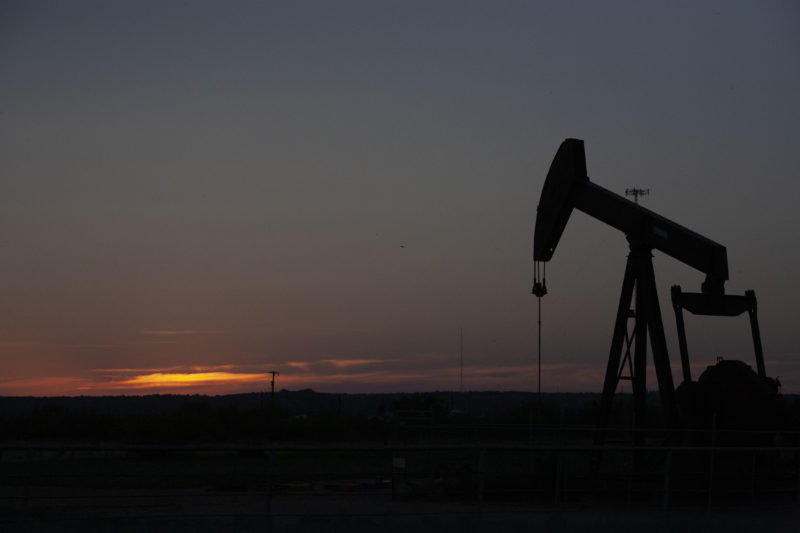Increased Production Could Lead to More Methane in the Permian Basin
By Samuel Stark
Reporting Texas

A pumpjack operates as the sun sets in the Permian Basin near Lubbock, Texas. Nuri Vallbona/Reporting Texas
Beneath the stark, dusty landscape of West Texas lie copious energy-rich substances that have fueled American automobiles and the Texas economy for over a century. These resources are now playing a role in America’s response to the war in Ukraine, raising new concerns for environmental advocates
After a slump at the start of the COVID-19 pandemic in March 2020 due to decreased demand, producers in the Permian Basin have been increasing their output.
“We are currently producing more natural gas and more crude oil on a daily basis than we ever have,” said Stephen Robertson, executive vice president of the Permian Basisn Petroleum Association.
Companies in the Permian Basin, which spans portions of Texas and New Mexico, have been producing hydrocarbons commercially since 1921. According to estimates from the Permian Basin Petroleum Association, the region now produces nearly half of the nation’s crude oil and a quarter of the nation’s natural gasses.
Some oil executives and industry groups are calling for an even greater increase in production to fill the void created by sanctions on Russia, another top producer, after its invasion of Ukraine more than two months ago. Among other reasons, many hope more resources from the Permian Basin will alleviate record-breaking prices at the pump.
But Texas environmentalists are concerned that this ramp-up will lead to dire consequences. “The increased production is going to exacerbate pretty much every problem,” said Michael Lewis, a clean air and water advocate at Environment Texas.
The biggest of the environmental problems, Permian Basin scientists say, is methane loss from leaks and methane flaring, the process of burning off excess natural gas from oil and gas production sites.
Colin Leyden of the Environmental Defense Fund pointed to a recent study showing a methane loss rate of 9.4% of gross petroleum production from some sites in the Permian Basin, “which is outrageously high,” he said. His organization consistently sees a methane loss rate of 3% to 3.5%, Leyden said. Further, according to their research, methane emissions in the Permian Basin are three times greater than EPA estimates.
Methane is a potent greenhouse gas often emitted in oil production that has contributed 0.6 degrees Celsius to global warming, according to climate research. Methane’s global warming potential is 28 to 36 times higher than that of carbon dioxide, another natural gas that contributes to climate change, according to the EPA.
Scientists say reducing methane gas emissions is critical to reaching climate goals. Some flaring can be necessary for safety or emergency reasons, but the amount of flaring in the region is gratuitous and can be reduced, Leyden said.
“Unlike New Mexico and Colorado who have banned routine flaring, Texas continues to refuse to do that. (This) is why we need the EPA to ban routine flaring across the country. There’s just no viable path for natural gas if routine flaring continues,” Leyden said.
“It’s absolutely possible for companies to operate and make money without routine flaring,” Leyden said, citing Houston-based Apache Corp.’s decision to end flaring in 2021. He also noted that British Petroleum has said it will end routine flaring by 2025.
Lewis said unchecked methane leaks also pose an environmental concern. “(Texas Commission of Environmental Quality) has roughly one inspector per 2,000 inspections that need to happen,” said Lewis who now works for Environment Texas but grew up near the oilfields working the rigs over his high school summers.
“A lot of problems around production can be lessened by some very simple regulations and safety methods,” he said.
Since November 2021, production in the Permian Basin has been on a slow and steady ascent.
“It is absolutely not as simple as (opening) the spigot or (flipping) a switch, and all of a sudden, you’ve got a production unit. It takes investment, it takes growth, it takes establishing infrastructure to get that production on the market and to work,” Robertson said.
The region has also been facing labor shortages that prevent an abrupt increase in production.
“Many of the employers we’ve talked to are not at full employment yet. They’re struggling to get there,” said Tom Manskey, director of Economic Development for the Odessa Chamber of Commerce.
Other businesses in the Permian Basin are offering more competitive salaries to nab workers who may be worn out by the arduous work in the oilfields. “Family Dollar has a large distribution center out (in Odessa). And they’ve increased their minimum wage to $19 an hour,” Manskey said.
Robertson of the Permian Basin Petroleum Association said some of the environmentalists’ concerns are overblown.
“In the United States, because of our regulatory schemes, our productions of hydrocarbon can be done more environmentally consciously and friendly in the United States than in many other producing regions around the world,” Robertson said. “It makes economic and environmental sense to support operations here versus supporting them in places like Russia and Venezuela.”
Robertson said that much has been done to reduce methane leaks and the frequency of flaring already. But old equipment could be upgraded to avoid unnecessary methane leaks, he admitted.
“With over 100 years of commercial production out here, there is old equipment that needs to get replaced. And there are some emission issues that go along with that. We greatly support the improvement of all types of operations in the Permian Basin, that limit if not eliminate any kind of leaks, but also any kind of unnecessary venting and flaring,” Robertson said.
Leyden disagrees.
“The idea that that the methane issue is not an issue in the Permian Basin, it’s just flatly false,” Leyden said. “We’ve seen improvements at the individual company level. But we don’t have a regulatory framework to make sure that we don’t return to high levels of flaring intensity.”